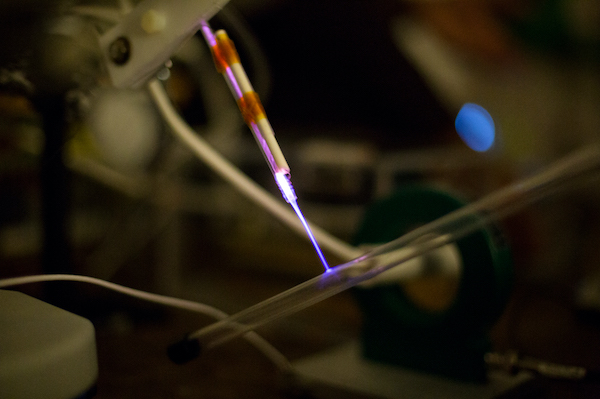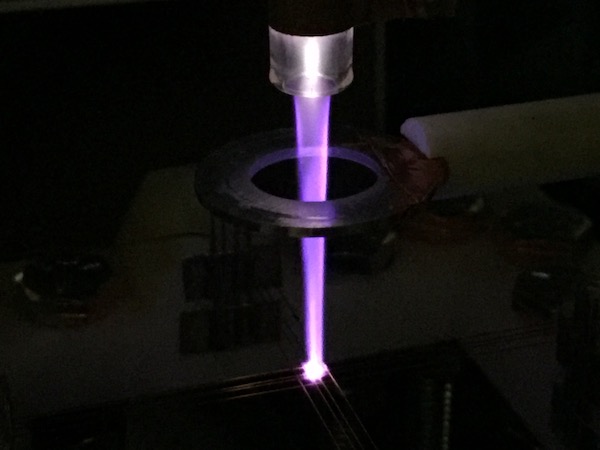Plasma-Based Technology to Fight COVID-19
From plasma-created nanoparticles to plasma-driven ultraviolet lights, plasma-based technology is on its way to fight the COVID-19 pandemic.
November 9, 2020
VIRTUAL MEETING (CST) -- Plasmas are ionized gases that contain many active components, including charged electrons and ions, ultraviolet (UV) radiation, and reactive gas species. These components make plasmas highly effective in killing microbial pathogens such as the virus causing the COVID-19 pandemic.
Dr. Igor Kaganovich of the Princeton Plasma Physics Laboratory and Prof. Michael Keidar of The George Washington University will present the latest results in developing plasma-based applications to ameliorate COVID-19 at two mini-conference sessions during the virtual 62nd Annual Meeting of the APS Division of Plasma Physics.
These plasma-based applications can be safe and highly effective. While some plasmas exist in extremely high temperature and pressure environments, laboratory scientists can produce “cold” plasmas at atmospheric pressure—with only electrons at elevated temperature, and heavier particles at room temperature. In addition, just a few of the millions of atoms in cold plasmas are ionized, making cold atmospheric plasma safe for use on and near humans, which is leading to the rapid growth of plasma-based applications in biomedicine. Moreover, since atmospheric cold plasmas do not require a liquid agent as traditional disinfectants do, they do not cause corrosion of materials and do not create toxic chemicals.
Some uses for cold atmospheric plasma to be discussed at the mini-conference include:
- Dielectric barrier discharges (DBD). Scientists from the U.S. Department of Energy’s Princeton Plasma Physics Laboratory (PPPL) and the New Jersey Institute of Technology are using a flexible printed circuit design to develop a cold-atmospheric plasma that uses a dielectric barrier discharge. Such discharges are generated between two electrodes separated by an insulating dielectric barrier. They can treat flat or curved surfaces in air with no additional gas flow and reduce the concentration of bacteria on a glass surface by 99.99% when in direct contact with the device.
- Plasma globes & d'Arsonval sources. PPPL scientists and colleagues from Rutgers New Jersey Medical School have also examined the efficacy of commercially available home-use plasma devices for the rapid and inexpensive antiviral treatment of surfaces. These devices include a d'Arsonval high-frequency current source and a plasma globe. Both easy-to-use devices create plasma through the DBD process and are readily available for public purchase through online markets.
- Plasma-activated water. A plasma device developed and patented by inventor Pavel Dourbal of Dourbal Electric, Inc., can produce cold-plasma-activated water with silver nanoparticles. The silver nanoparticles generated via in-water plasma on silver electrodes has shown promising potential for anti-viral nasal/oral spray that inhibits COVID-19 virus in situ and could treat intestinal symptoms and complications.
- Plasma jet wand. Researchers at the University of Michigan are developing a plasma jet wand which generates and emits ions in a focused beam that can destroy bacteria and viruses in seconds (Figure 1). As the technique is rapid and contactless, it can be applied to both hard and soft surfaces without damaging either one. This technology is appropriate for use in public spaces and areas used by many individuals over the course of a day, which are generally difficult to disinfect with a quick turnover time.
- Plasma brush. To help decontaminate protective masks, gloves, and other necessary reusable gear, scientists at The George Washington University are working on a plasma brush (Figure 2). This technology, based on previous success in using cold plasma for cancer treatment, also has the potential to treat airborne viruses. Earlier this year the National Science Foundation awarded a Rapid Response Research grant (RAPID) to a team that includes George Washington University, the University of Michigan, and Drexel University to develop low-temperature plasma approaches to ameliorate COVID-19. The project will develop a disinfection system based on cold adaptive atmospheric plasma in combination with rapid detection of the contamination on these surfaces. Learn more on YouTube.
- Plasma-driven UV lamps. The widespread use of UV disinfection technology for air and water is based on a sharp increase in the power and lifetime of UV lamps. These lamps emit light by sending electric discharges through mixtures of argon-neon and mercury vapor at low pressure. Increasing the power of UV lamps to 300-350 watts with an efficiency of about 35% in the 254 nanometer UV wavelength—which is particularly effective against pathogens—has made it possible to create equipment for water disinfection. To disinfect air and surfaces, researchers at the Russian Academy of Science are developing special high-power UV lamps for open irradiators and closed recirculating irradiators to be used in air conditioning and ventilation systems.
A key advantage of plasma-based therapies is their adaptive nature. Such therapies are easily varied based on input parameters—electrical input, voltage, current, and type of gas—unlike the fixed chemical composition of most drugs and disinfectants. This capability can allow scientists to monitor the efficacy of plasma-based treatments and almost instantaneously adjust the plasma composition based on that feedback. Scientists are developing rapid detection techniques to realize this feature. All these benefits suggest that cold atmospheric plasmas are a powerful tool in fighting the global pandemic.
Sessions:
TM13 Mini-Conference on Plasma Applications to Ameliorate Covid-19 I
9:30 a.m. - 12:20 p.m. CST, Thursday, November 12, 2020
VM09 Mini-Conference on Plasma Applications to Ameliorate Covid-19 II
2:00 p.m. - 5:00 p.m. CST, Thursday, November 12, 2020

Figure 1. An example of a plasma jet wand that can be used for disinfection. Credit: Joseph Xu, University of Michigan.

Figure 2. A “plasma brush” for cleaning protective gear. Credit: Li Lin.
Media Contact
APS Press Office
media@aps.org
Igor Kaganovich
Princeton Plasma Physics Laboratory
ikaganov@pppl.gov
Michael Keidar
George Washington University
keidar@gwu.edu
